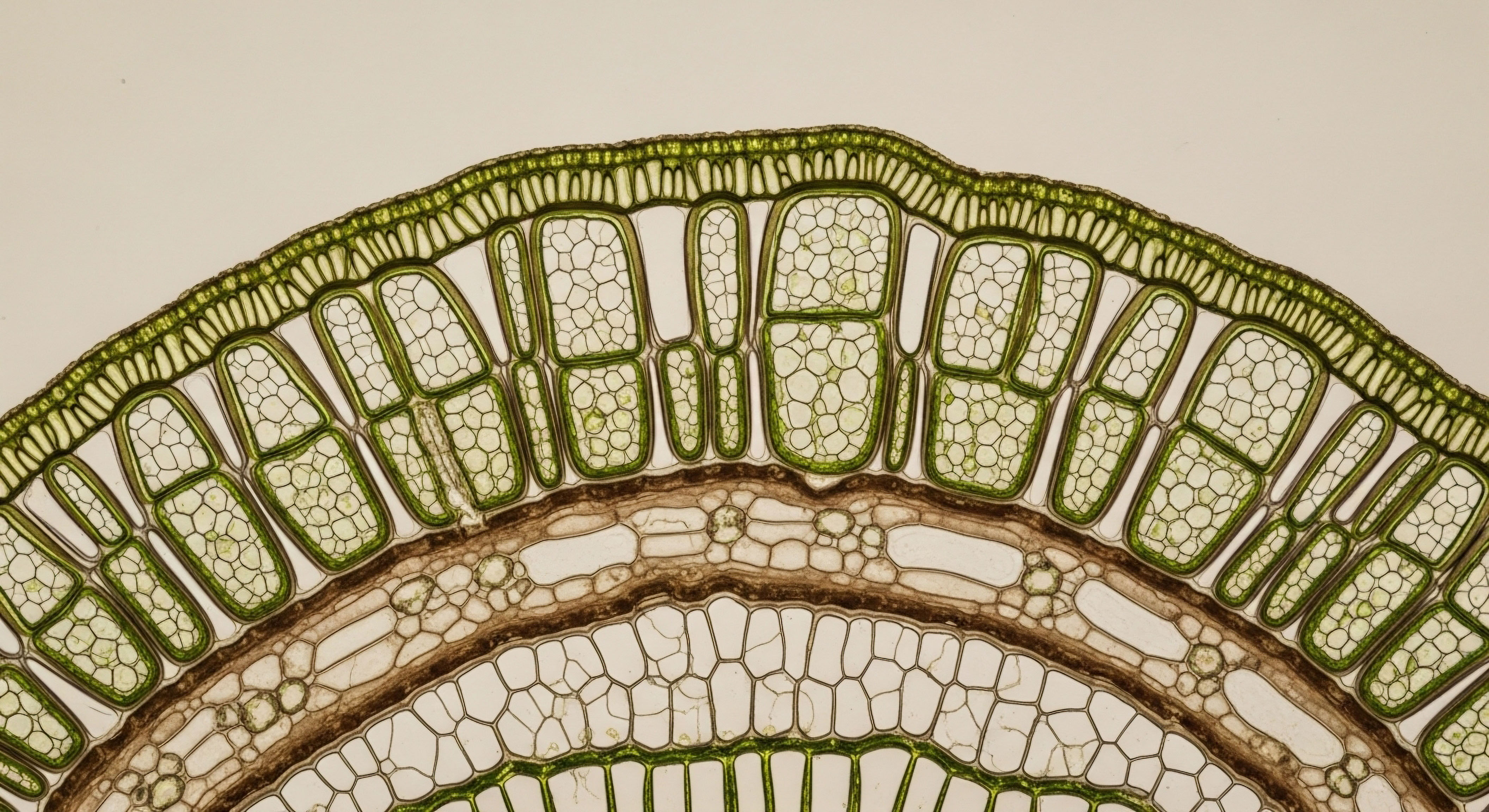

Fundamentals
The persistent feeling of bloating, the subtle but draining fatigue that clouds your afternoon, or the confusing reactivity to foods you once enjoyed are tangible experiences. These sensations are your body’s sophisticated communication system at work, sending signals from the very core of your being, the gastrointestinal tract.
Your personal health journey begins with learning to interpret this language. The conversation starts at the gut barrier, an extensive, intelligent surface that governs the relationship between your internal world and the external environment you introduce with every meal. Understanding how to support this barrier is fundamental to reclaiming vitality.
Two distinct and powerful tools have become central to this conversation peptide therapies and probiotics. Viewing them as opposing forces is a limited perspective. A more accurate clinical viewpoint sees them as allies with different methods of operation, each addressing the integrity of the gut barrier from a unique angle.
Probiotics represent a foundational, ecological approach. They are living microorganisms that, when administered in adequate amounts, confer a health benefit on the host. Think of them as cultivating a vibrant, resilient inner garden. Their work is broad and systemic. They establish communities that produce beneficial compounds, reinforce the physical structure of the gut wall, and educate the resident immune cells, creating an environment of balance and strength.
Probiotics act as ecological cultivators, fostering a healthy gut environment, while peptides are precision messengers that deliver direct commands for cellular repair and modulation.
Peptide therapies, conversely, operate with the precision of a skilled technician. These agents are short chains of amino acids, the building blocks of proteins, designed to function as highly specific biological messengers. Each peptide carries a direct, unambiguous instruction for the cells it targets.
One peptide might command damaged cells in the gut lining to accelerate repair and regeneration. Another might instruct overactive immune cells to stand down, quieting the fires of inflammation. This approach is targeted, delivering a potent signal to achieve a specific outcome. Their role is to intervene directly at points of system failure, restoring function with focused action.
The integrity of the gut barrier is therefore maintained through two complementary philosophies. One is the holistic cultivation of a healthy ecosystem through probiotics, ensuring the foundational resilience of the entire system. The other is the precise, targeted intervention of peptide therapies, which act as biological specialists to repair, regulate, and restore specific functions.
The true power lies in understanding how these two approaches can be strategically combined, creating a comprehensive protocol that both nurtures the system’s overall health and surgically corrects its most critical dysfunctions. This integrated understanding is the first step toward moving beyond managing symptoms and toward building a truly resilient biological system from the inside out.


Intermediate
To appreciate the distinct value of probiotics and peptides, we must examine their specific mechanisms of action at the cellular level. These are not vague wellness concepts; they are tangible biological processes rooted in complex signaling and structural reinforcement. Understanding these mechanisms allows for a strategic application, moving from a general hope for improvement to a targeted protocol based on physiological need.

The Ecological Engineering of Probiotics
Probiotics are far more than transient passengers in the gut. Their influence is profound, reshaping the gut’s physical structure and chemical environment. They achieve this through several coordinated actions.
One of their primary functions is the enhancement of the mucosal barrier. The intestinal lining is coated in a layer of mucus, a glycoprotein matrix that serves as the first line of defense, physically separating luminal contents from the epithelial cells.
Certain probiotic strains stimulate goblet cells to produce more of this protective mucus, thickening the barrier and making it more difficult for pathogenic organisms to adhere to the gut wall. They also engage in competitive exclusion, occupying binding sites on the epithelium that might otherwise be colonized by harmful bacteria. This is a simple, powerful principle of microbial real estate they claim the territory, leaving no room for invaders.
The strategic selection of probiotic strains allows for the targeted reinforcement of the gut barrier, addressing specific vulnerabilities from mucus production to intercellular integrity.
Perhaps the most significant contribution of probiotics is their metabolic activity. Through the fermentation of dietary fibers that are indigestible to humans, specific bacteria produce short-chain fatty acids (SCFAs). The three primary SCFAs are butyrate, propionate, and acetate. Butyrate is particularly important as it serves as the principal energy source for colonocytes, the cells lining the colon.
A well-nourished colonocyte is a healthy, functional cell, better equipped to maintain the integrity of the barrier. Beyond serving as fuel, SCFAs act as signaling molecules that strengthen the tight junctions, the protein complexes that bind adjacent epithelial cells together, effectively “zipping” them shut to prevent leakage.

Key Probiotic Strains and Their Functions
Different probiotic strains have demonstrated distinct abilities in clinical research. This allows for a more tailored approach to supplementation based on specific health goals.
| Probiotic Strain | Primary Mechanism for Gut Barrier Support | Clinical Relevance |
|---|---|---|
| Lactobacillus rhamnosus GG | Promotes cell survival and growth, increases mucus production, and prevents pathogen adhesion. | Well-researched for preventing antibiotic-associated diarrhea and supporting overall gut homeostasis. |
| Lactobacillus plantarum | Upregulates the expression of tight junction proteins like occludin and ZO-1, directly strengthening the seal between cells. | Often used in protocols for reducing symptoms of Irritable Bowel Syndrome (IBS) and mitigating inflammatory responses. |
| Bifidobacterium lactis | Enhances the immune function of the gut lining and has been shown to protect against the disruptive effects of certain toxins. | Supports a healthy immune response and helps maintain barrier integrity during periods of stress. |
| Saccharomyces boulardii | A beneficial yeast that secretes factors that neutralize bacterial toxins and reduce inflammation. | Particularly effective for preventing and treating infectious and antibiotic-induced diarrhea. |

The Precision Signaling of Peptide Therapies
Peptide therapies provide a level of targeted intervention that probiotics, by their nature, cannot. They are specific keys designed to fit specific molecular locks, initiating a cascade of predictable downstream effects. For gut barrier support, several peptides have demonstrated remarkable efficacy.

Specialized Peptides for Gut Restoration
Each peptide has a unique mechanism of action, making them suitable for different aspects of gut repair.
- Body Protection Compound 157 (BPC-157) This peptide, derived from a protein found in human gastric juice, is a powerful agent of tissue repair. Its primary mechanism is the promotion of angiogenesis, the formation of new blood vessels. By increasing blood flow to damaged areas of the gut lining, it accelerates the delivery of oxygen and nutrients necessary for healing. BPC-157 also exhibits potent anti-inflammatory properties, helping to quell the chronic inflammation that often perpetuates barrier dysfunction. It acts as a comprehensive repair signal, rebuilding damaged tissue from the ground up.
- KPV (Lysine-Proline-Valine) This tripeptide is the active anti-inflammatory fragment of a larger hormone, alpha-melanocyte-stimulating hormone (α-MSH). Its genius lies in its ability to penetrate cells and directly interact with inflammatory signaling pathways. It can enter the cell nucleus and inhibit the activation of NF-κB, a master regulator of the inflammatory response. By shutting down this pathway, KPV effectively turns off the production of numerous pro-inflammatory cytokines, molecules that drive conditions like Inflammatory Bowel Disease (IBD).
- Larazotide Acetate This peptide offers a highly specialized function it acts as a regulator of tight junctions. It functions as an antagonist to zonulin, a protein that modulates the permeability of the gut barrier. In certain conditions, like celiac disease, zonulin levels increase, causing tight junctions to disassemble and the barrier to become “leaky.” Larazotide acetate prevents this from happening by blocking the zonulin receptor, thereby keeping the tight junctions intact and preserving the barrier’s integrity.
The comparison between these two modalities reveals their complementary nature. Probiotics are the long-term ecological strategy, fostering a resilient and self-sustaining barrier environment. Peptides are the acute, targeted intervention, delivering precise commands to repair damage, reduce inflammation, or reinforce specific structural components. An optimized wellness protocol often involves both establishing a healthy microbial foundation with probiotics and using peptides to address specific, persistent points of dysfunction.


Academic
A sophisticated clinical analysis of gut barrier function extends beyond the local environment of the intestine and into the realm of systems biology. The gut is not an isolated organ; it is a dynamic neuroendocrine control center that engages in constant, bidirectional communication with the rest of the body.
The integrity of the intestinal barrier is a critical determinant in the quality of this systemic signaling. A compromised barrier introduces inflammatory “noise” into the system, disrupting the precise hormonal choreography that governs metabolic health, stress response, and reproductive function. Understanding this connection is essential for developing protocols that address root causes rather than just downstream symptoms.

The Gut-Endocrine Axis a Nexus of Communication
The dialogue between the gut microbiota and the body’s master regulatory systems is profound. One of the most critical pathways is the microbiota-gut-brain axis, which heavily involves the Hypothalamic-Pituitary-Adrenal (HPA) axis. The HPA axis is the body’s primary stress response system, culminating in the adrenal glands’ production of cortisol. A healthy gut microbiome and an intact barrier are crucial for maintaining normal HPA axis tone.
When the gut barrier is compromised, a condition clinically referred to as increased intestinal permeability, fragments of gram-negative bacteria known as lipopolysaccharides (LPS) can translocate from the gut lumen into systemic circulation. This phenomenon, known as metabolic endotoxemia, is a potent trigger of inflammation.
LPS binds to Toll-like receptor 4 (TLR4) on immune cells, initiating a signaling cascade that results in the production of pro-inflammatory cytokines like Tumor Necrosis Factor-alpha (TNF-α) and Interleukin-6 (IL-6). This state of chronic, low-grade systemic inflammation places a constant, unyielding stress on the HPA axis, leading to its dysregulation.
This can manifest as abnormal cortisol rhythms, which in turn disrupt downstream hormonal systems, including the Hypothalamic-Pituitary-Gonadal (HPG) axis that controls the production of testosterone and estrogen.
Metabolic endotoxemia resulting from a compromised gut barrier directly dysregulates the HPA axis, creating a state of systemic inflammation that disrupts the entire endocrine system.

How Does Gut Barrier Dysfunction Impact Hormonal Health?
The connection between gut health and hormonal balance is direct and clinically significant. For an individual presenting with symptoms of hormonal imbalance, addressing the gut barrier may be a prerequisite for successful treatment.
- Suppression of Gonadal Function Chronic inflammation driven by metabolic endotoxemia can directly suppress the function of the testes and ovaries. Inflammatory cytokines can inhibit the release of Gonadotropin-Releasing Hormone (GnRH) from the hypothalamus, leading to reduced output of Luteinizing Hormone (LH) and Follicle-Stimulating Hormone (FSH) from the pituitary. For a male patient, this translates to lower testosterone production. For a female patient, it can manifest as menstrual irregularities and impaired fertility.
- Insulin Resistance Systemic inflammation is a known driver of insulin resistance. When cells become resistant to insulin, the pancreas must produce more of it to manage blood glucose. This state of hyperinsulinemia can further disrupt hormonal balance, for example, by increasing the conversion of testosterone to estrogen via the aromatase enzyme.
- Impaired Thyroid Function The gut is a major site for the conversion of inactive thyroxine (T4) to the active thyroid hormone triiodothyronine (T3). Gut dysbiosis and inflammation can impair this conversion, leading to symptoms of hypothyroidism even when standard thyroid markers appear normal.

A Synergistic Clinical Protocol
Given this interconnectedness, a truly effective protocol must be multi-faceted. It requires both cultivating a healthy gut ecosystem and delivering targeted signals for repair, all while understanding the downstream hormonal implications.

How Might Peptides and Probiotics Be Integrated in a Clinical Setting?
Consider a 45-year-old male presenting with fatigue, low libido, and brain fog, classic symptoms of low testosterone. Lab work confirms low testosterone levels, but also shows elevated markers of inflammation like hs-CRP and high-normal fasting insulin. A simplistic approach would be to immediately start Testosterone Replacement Therapy (TRT). A systems-based approach, however, would first question the origin of the inflammation.
A sophisticated protocol might look like this:
- Phase 1 Foundational Gut Restoration The initial focus is on reducing the inflammatory burden originating from the gut. This would involve a protocol of high-potency, multi-strain probiotics rich in species like L. plantarum to reinforce tight junctions. Simultaneously, a course of the peptide BPC-157 could be initiated to accelerate the healing of the damaged mucosal lining and quell local inflammation. This phase aims to “seal the barrier” and reduce the influx of LPS into circulation.
- Phase 2 Systemic Inflammation Control As the gut barrier heals, the peptide KPV could be introduced to directly inhibit systemic inflammatory pathways like NF-κB, further reducing the inflammatory load on the HPA and HPG axes. This helps to restore the body’s sensitivity to its own hormonal signals.
- Phase 3 Hormonal Recalibration Only after the underlying inflammatory issues have been addressed would hormonal optimization protocols like TRT be initiated. By first improving the body’s internal environment, the TRT protocol is likely to be more effective at lower doses, and the need for ancillary medications like aromatase inhibitors may be reduced. The body is now better prepared to receive and utilize the therapeutic hormones.
| Therapeutic Agent | Molecular Target | Systemic Effect |
|---|---|---|
| Probiotics (e.g. L. plantarum) | Tight Junction Proteins (Occludin, ZO-1) | Reduces intestinal permeability and LPS translocation. |
| BPC-157 | VEGF, Growth Hormone Receptors | Promotes angiogenesis and tissue regeneration in the gut lining. |
| KPV | NF-κB Inflammatory Pathway | Inhibits production of systemic pro-inflammatory cytokines. |
| Testosterone Cypionate | Androgen Receptors | Restores physiological testosterone levels after systemic inflammation is controlled. |
This integrated model demonstrates that the comparison is not about which therapy is “better.” The relevant question is how to sequence and combine them intelligently. Probiotics provide the essential ecological foundation, while peptides offer the targeted, potent signaling needed to repair specific points of failure. Together, they create a powerful synergy that addresses the root causes of dysfunction within the complex, interconnected network of the gut-endocrine system.

References
- Sikiric, P. et al. “Stable gastric pentadecapeptide BPC 157 ∞ novel therapy in gastrointestinal tract.” Current Pharmaceutical Design, vol. 17, no. 16, 2011, pp. 1612-32.
- Seiwerth, S. et al. “BPC 157 and standard angiogenic growth factors. Gut vessels healing.” Current Medicinal Chemistry, vol. 25, no. 15, 2018, pp. 1790-1801.
- Dalmasso, G. et al. “PepT1-mediated tripeptide KPV uptake reduces intestinal inflammation.” Gastroenterology, vol. 134, no. 1, 2008, pp. 166-78.
- Brzoska, T. et al. “The C-terminal tripeptide of alpha-MSH, KPV, is a potent inhibitor of Joint inflammation in a mouse model of antigen-induced arthritis.” Arthritis & Rheumatism, vol. 58, no. 6, 2008, pp. 1649-58.
- Slifer, Z. M. et al. “Larazotide acetate ∞ a pharmacological peptide approach to tight junction regulation.” American Journal of Physiology-Gastrointestinal and Liver Physiology, vol. 320, no. 6, 2021, pp. G983-G989.
- Cani, P. D. et al. “Changes in gut microbiota control metabolic endotoxemia-induced inflammation in high-fat diet-induced obesity and diabetes in mice.” Diabetes, vol. 57, no. 6, 2008, pp. 1470-81.
- Kelly, J. R. et al. “Breaking down the barriers ∞ the gut microbiome, intestinal permeability and stress-related psychiatric disorders.” Frontiers in Cellular Neuroscience, vol. 9, 2015, p. 392.
- Parada Venegas, D. et al. “Short Chain Fatty Acids (SCFAs)-Mediated Gut Epithelial and Immune Regulation and Its Relevance for Health and Disease.” Frontiers in Immunology, vol. 10, 2019, p. 277.
- Fasano, A. “Zonulin and its regulation of intestinal barrier function ∞ the biological door to inflammation, autoimmunity, and cancer.” Physiological Reviews, vol. 91, no. 1, 2011, pp. 151-75.
- Cryan, J. F. et al. “The Microbiota-Gut-Brain Axis.” Physiological Reviews, vol. 99, no. 4, 2019, pp. 1877-2013.

Reflection

Translating Knowledge into Personal Protocol
You have now explored the intricate cellular mechanics of gut barrier support, from the ecological cultivation offered by probiotics to the precision signaling of therapeutic peptides. This knowledge provides a detailed map of the biological territory. The next step in your personal health journey involves using this map to understand the signals your own body is sending. The symptoms you experience are a form of communication, a request from your internal systems for a specific type of support.
Consider the patterns of your own physiology. Do your symptoms suggest a need for broad, foundational support to re-establish a healthy internal environment? Or do they point toward a more specific, acute issue that might benefit from a targeted command for repair?
The information presented here is designed to empower you with a deeper understanding of the available tools. This clarity is the foundation upon which a truly personalized and effective wellness protocol is built, a protocol that honors the unique complexity of your individual biology and moves you toward a state of resilient, functional health.



